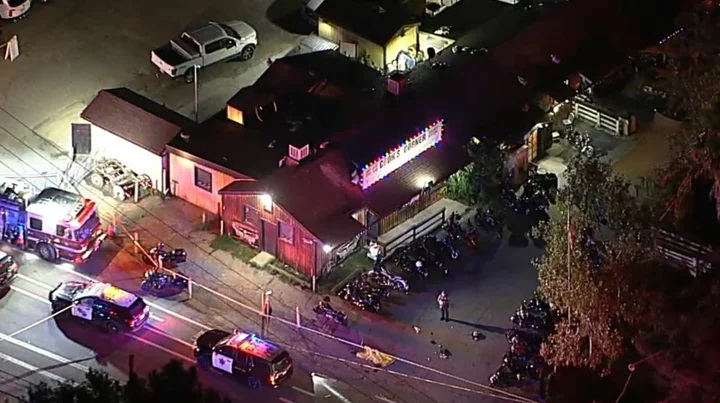The remains of a mountain climber who vanished on a Swiss glacier in 1986 have been recovered after they were revealed by melting ice. DNA tests confirmed the remains were those of the 38-year-old hiker from Germany who went missing nearly four decades ago near the Matterhorn mountain, Switzerland’s most famous peak. A huge search at the time failed to find any trace of him. Police in the Valais canton said: “DNA analysis enabled the identification of a mountain climber who had been missing since 1986. “In September 1986, a German climber, who was 38 at the time, had been reported missing after not returning from a hike.” The force did not give the climber’s identity nor information on the circumstances of his death. Climbers crossing the Theodul glacier above Zermatt this month had spotted a hiking boot and crampons emerging from the ice. Alpine glaciers are increasingly giving up long-held secrets as the planet heats up, accelerating the rate of glacier retreat. In 2015, the remains of two young Japanese climbers who went missing on the Matterhorn in a 1970 snowstorm were found and their identities were confirmed through the DNA testing of their relatives. In 2014 the body of missing British climber Jonathan Conville, missing since 1979 on the Matterhorn, was discovered by a helicopter pilot. His family said finally knowing he had died in an environment he loved was bittersweet. Last year plane parts were found on the Aletsch glacier from a Piper Cherokee that crashed in 1968. And two sets of human remains were also revealed – one thought to have died in the 1970s or 1980s on the Chessjen glacier, and one on the Stockji glacier in the 1980s. Switzerland has more glaciers – 1,400 – than any other country in Europe, accounting for about half of all those in the European Alps. Swiss glaciers experienced record melting last year, losing more than 6 per cent of their volume and alarming experts at the Swiss Academy of Sciences who said a loss of 2 per cent would once have been considered extreme. Separate research found that the country’s glaciers had lost more than half their total volume since the early 1930s – a much faster shrinkage than scientists had forecast. At that rate, they said, almost all the Alpine glaciers would be gone by the end of this century. “Glacier retreat is accelerating. Closely observing this phenomenon and quantifying its historical dimensions is important because it allows us to infer the glaciers’ responses to a changing climate,” said Daniel Farinotti, a co-​author of the study. Alpine glaciers irrigate crops, and melt water from them cools rivers, so is vital to biodiversity including fish. The glaciers also collect pools of water in “ice dams”, which threaten flooding if the water is released. European glaciers are projected to lose more than 80 per cent of their current mass by 2100 under a high-emissions worst-case scenario, and many will disappear regardless of the emission scenario, according to a 2019 IPCC report. Read More Climate change comes for European skiing: After deadly conditions and closed runs, is this the beginning of the end? Floods, fires and deadly heatwaves are the alarm bells of a planet on the brink Summer 2022 was ‘a sign of things to come’ for UK climate, says Met Office Alaska man inadvertently films his own drowning on a glacial lake with helmet GoPro Russia: Putin ‘threatening civilian ships in Black Sea’ as Ukraine advances - latest Ukraine’s troops advance around Bakhmut despite intense artillery fire, military say
The remains of a mountain climber who vanished on a Swiss glacier in 1986 have been recovered after they were revealed by melting ice.
DNA tests confirmed the remains were those of the 38-year-old hiker from Germany who went missing nearly four decades ago near the Matterhorn mountain, Switzerland’s most famous peak.
A huge search at the time failed to find any trace of him.
Police in the Valais canton said: “DNA analysis enabled the identification of a mountain climber who had been missing since 1986.
“In September 1986, a German climber, who was 38 at the time, had been reported missing after not returning from a hike.”
The force did not give the climber’s identity nor information on the circumstances of his death.
Climbers crossing the Theodul glacier above Zermatt this month had spotted a hiking boot and crampons emerging from the ice.
Alpine glaciers are increasingly giving up long-held secrets as the planet heats up, accelerating the rate of glacier retreat.
In 2015, the remains of two young Japanese climbers who went missing on the Matterhorn in a 1970 snowstorm were found and their identities were confirmed through the DNA testing of their relatives.
In 2014 the body of missing British climber Jonathan Conville, missing since 1979 on the Matterhorn, was discovered by a helicopter pilot.
His family said finally knowing he had died in an environment he loved was bittersweet.
Last year plane parts were found on the Aletsch glacier from a Piper Cherokee that crashed in 1968.
And two sets of human remains were also revealed – one thought to have died in the 1970s or 1980s on the Chessjen glacier, and one on the Stockji glacier in the 1980s.
Switzerland has more glaciers – 1,400 – than any other country in Europe, accounting for about half of all those in the European Alps.
Swiss glaciers experienced record melting last year, losing more than 6 per cent of their volume and alarming experts at the Swiss Academy of Sciences who said a loss of 2 per cent would once have been considered extreme.
Separate research found that the country’s glaciers had lost more than half their total volume since the early 1930s – a much faster shrinkage than scientists had forecast. At that rate, they said, almost all the Alpine glaciers would be gone by the end of this century.
“Glacier retreat is accelerating. Closely observing this phenomenon and quantifying its historical dimensions is important because it allows us to infer the glaciers’ responses to a changing climate,” said Daniel Farinotti, a co-​author of the study.
Alpine glaciers irrigate crops, and melt water from them cools rivers, so is vital to biodiversity including fish.
The glaciers also collect pools of water in “ice dams”, which threaten flooding if the water is released.
European glaciers are projected to lose more than 80 per cent of their current mass by 2100 under a high-emissions worst-case scenario, and many will disappear regardless of the emission scenario, according to a 2019 IPCC report.
Read More
Climate change comes for European skiing: After deadly conditions and closed runs, is this the beginning of the end?
Floods, fires and deadly heatwaves are the alarm bells of a planet on the brink
Summer 2022 was ‘a sign of things to come’ for UK climate, says Met Office
Alaska man inadvertently films his own drowning on a glacial lake with helmet GoPro
Russia: Putin ‘threatening civilian ships in Black Sea’ as Ukraine advances - latest
Ukraine’s troops advance around Bakhmut despite intense artillery fire, military say









